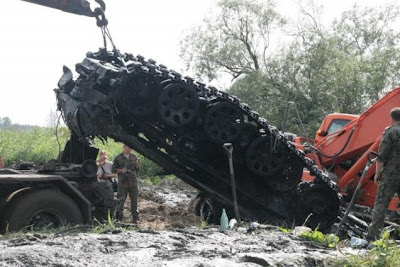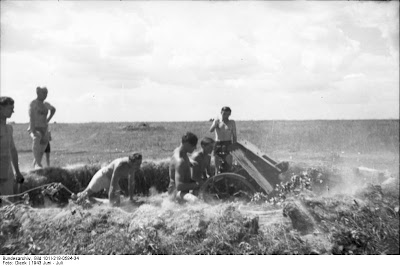Aparatos, actuación y su organización
Avia B.534
En el verano de 1939 la Fuerza Aérea búlgara compró al Wirschaftsgruppe Luftfahrtindustrie en Berlín, un total de 78 cazas Avia B.534 para mejorar la dotación de este tipo de aparatos. Fueron enviados por tren hasta Karlovo y despachados al 2º Orlyak Istrebitelen (2º Regimiento de Cazas). Cada uno de sus 4 yatos (escuadrones) se equipó con 15 cazas Avia B.534, mientras que el yato de entrenamiento recibió otros doce. Estas unidades se ubicaron en los aeródromos de Karlovo y Vrazhdebna (cerca de la capital de Sofía). Tras el ataque serbio sobre Kjustendil, al oeste de la capital, el 2º Orlyak fue enviado a Bozuriste.
En marzo de 1942 el 6º Orlyak Istrebitelen recibió algunos cazas Avia B.534 que fueron repartidos entre el 612º yato, en el campo de aviación de Vrazhdebna, y el 622º yato, ubicado en Bozhurishte, cerca de la capital Sofia. Esta unidad, la 6º Orlyak, era una unidad de caza mixta y disponía también de cazas Messerschmitt Bf 109 en su inventario.
El 1 de agosto de 1943 los Avia B.534 fueron enviados contra la incursión de bombarderos B-24 Libertador sobre las refinerías rumanas de Ploiesti, constituyendo el mayor enfrentamiento de este tipo de aparatos en la guerra. A las 12:25 seis cazas B.534 pertenecientes al 612º yato partieron del campo de aviación de Vrazhdebna mientras que otros 4 aparatos de la misma clase, esta vez pertenecientes al 622º yato, hicieron lo propio desde Bozhurishte. Al mismo tiempo también partieron al combate los 10 Bf 109 G-2 del 6º Orlyak desde Karlovo. De todos estos aparatos, solo el pilotado por el podporuchyks Vaptzarov y Daskalov (que volaba en un Avia) hizo contacto visual con los bombarderos a lo lejos, sobre el río Danubio.

A las 15:00 horas los bombarderos estadounidenses regresaron y los cazas búlgaros volvieron a intentarlo. Cuatro B.534 despegaron desde Bozhurishte y siete lo hicieron desde Vrazhdebna. Desde Karlovo despegaron cuatro Bf 109 liderados por el porutzyk Stoyan Stoyanov para participar en la acción. Los Avia B.534 ascendieron hasta su límite y se comenzaron a encontrar con pequeños grupos de Liberator que iban rumbo al norte. El combate se produjo entre las localidades de Vratza y Ferdinand a una altitud de 3.000 metros. Un grupo de 7 cazas interceptaron los bombarderos atravesando la formación enemiga sin mayores consecuencias. La velocidad del Avia era tan solo un poco superior a la de los bombarderos y tardaron un tiempo en volver a darles caza. Cerca de Kjustenil los Avia volvieron a interceptarlos lanzando un segundo ataque a pesar del denso fuego defensivo y lanzaron otro más. Sin embargo el armamento de los Avia era demasiado ligero como para abatir uno de estos bombarderos bien protegidos. Algunos de los cazas resultaron destruidos durante los aterrizajes posteriores.
Había quedado de manifiesto que la vida operativa de los cazas Avia B.534 había llegado a su fin. Los aparatos que había sobrevivido fueron transferidos al 2º Orlyak Shturmovy (2º Regimiento de Ataque a Tierra) que los empleó para equipar a su 2º yato. A partir del 30 de agosto de 1944 disponía aún de 19 Avia B.534 “Dogans” (como lo apodaron los búlgaros) con 10 de ellos operativos.
Entre junio y agosto de 1944 los Aliados bombardearon los campos de aviación búlgaros destruyendo muchos Avia en tierra. Otro Avia resultó destruido cuando participaba en misiones contra los partisanos comunistas y algunos más se perdieron en accidentes. El 9 de septiembre de 1944 Bulgaria dejó el Eje y comenzó su lucha contra sus antiguos aliados.
Durante la lucha contra los alemanes estas dos unidades volaron 211 misiones en conjunto, entre el 10 de septiembre y el 12 de noviembre de 1944. En ese periodo exigieron la destrucción de 22 piezas de artillería, 52 vehículos a motor, 4 carros de combate, 62 carros hipomóviles, un tren militar. También efectuaron misiones de ataque y reconocimiento con sus Ju 87 búlgaras.
El 10 de septiembre de 1944 a las 06:40 horas seis Bf 109 alemanes fueron interceptados por otros 6 Avia búlgaros sobre la parada de tren de Verinsko. Los Bf 109 atacaron primero y los Avia trataron de responder pero los cazas alemanes no quisieron comprometerse en una lucha de perros a baja altitud, cota en la que los Avia eran más maniobreros. Sin embargo uno de los cazas búlgaros cayó bajo el fuego de los cazas alemanes (Avia B.534, marcado con el número 26) aunque su piloto, Vesselinov, sobrevivió al lance.
El 15 de septiembre el Avia B.534 Nº.63 cayó abatido por la flak sobre Tzurkvitza, cerca de Kjustendil sobreviviendo el piloto a la acción. Tres días más tarde el Avia B.534 Nº 19 también fue alcanzado por la flak, logrando tomar tierra poco después. El aparato fue recuperado y reparado después. El día 24 el Nº 58 corrió exactamente la misma suerte.
Según los datos el 2º Orlyak Shturmovy disponía de 6 Avia en su inventario el 1 de enero de 1945, cuando estaban operando en Hungría, mientras que varios B.534 reaparecieron en el 2º Orlyak Istrebitelen (otoño de 1944) dónde terminaron por ser dados de baja en el verano de 1945.
Bibliografia:
Avia B-534 - Jirí Vraný, 1994 MBI, Praha, ISBN 80-901263-6-7
English version
In the summer of 1939 the Bulgarian Air Force bought the Wirschaftsgruppe Luftfahrtindustrie in Berlin, a total of 78 fighters Avia B.534 for improving the supply of such equipment. They were sent by train to Karlovo and released to the 2 nd Orlyak Istrebitel (2 nd Fighter Regiment). Each its 4 yatos (squadrons) was equipped with 15 fighters Avia B.534, while yato training received other twelve. These units are located in airports and Vrazhdebna Karlovo (near the capital of Sofia). After attack Serb on Kjustendil, western capital on 2 º Orlyak was sent Bozuriste.
In March 1942 the 6th Orlyak Istrebitel Avia B.534 received some fighters that were distributed among the 612 º yato in Vrazhdebna airfield, and 622 º yato, Bozhurishte located near the capital Sofia. This unit, the 6th Orlyak was a mixed fighter unit also available Messerschmitt Bf 109 fighters in its inventory.
On August 1, 1943 the Avia B.534 were sent against the incursion of B-24 Liberator bombers on the Romanian refineries of Ploiesti, constituting the largest clash of such devices in the war. At 12:25 six fighters belonging to 612 º B.534 yato left the airfield while others Vrazhdebna 4 devices in the same class, this time belonging to 622 º yato, did the same from Bozhurishte. At the same time also departed to fight the 10 Bf 109 G-2 of the 6 th Orlyak from Karlovo. Of all these devices, only driven by the podporuchyks Vaptzarov and Daskalov (flying in an airplane) made eye contact with the bombers in the distance, over the river Danube.
At 15:00 pm on U.S. bombers and fighters returned Bulgarians tried again. Four B.534 took off from Bozhurishte and seven did so from Vrazhdebna. From Karlovo Bf 109 took off four led by Stoyan Stoyanov porutzyk to participate in the action. The Avia B.534 rose to its limit and began to find small groups of Liberator who were heading north. Combat occurred between localities Vratza and Ferdinand at altitudes 3,000 meters. A group of 7 fighters intercepted the bombers through the enemy formation without major consequences. Avia speed was only slightly higher than that of the bomber and took a while to hunt them again. About the Avia Kjustenil intercept again launching a second attack despite heavy defensive fire and threw another. But the arming of the Avia was too light to bring down one of these bombers protected. Some of the fighters were destroyed during subsequent landings.
It had become clear that the operational life of Avia B.534 fighters had come to an end. The devices that survived were transferred to 2 ° Orlyak Shturmovy (2 º Ground Attack Regiment) who used them to equip their 2nd yato. Beginning August 30 1944 yet available 19 Avia B.534 "Dogans" (as nicknamed Bulgarians) with 10 of them operational.
Between June and August 1944 the Allies bombed the airfields destroying many Avia Bulgarian land. Another Avia was destroyed when he participated in missions against the Communist partisans and some more were lost in accidents. On September 9, 1944 Bulgaria left the Axis and began his fight against their former allies.
During combating Germans these two units flew 211 missions together between 10 September and November 12 1944. During that time demanded the destruction of 22 guns, 52 motor vehicles, 4 tanks, 62 trucks hypomobile, a military train. Also carried out reconnaissance and attack missions with Bulgarian Ju 87.
On September 10, 1944 at 06:40 hours six German Bf 109 were intercepted by another 6 Avia Bulgarians on Verinsko train stop. The Bf 109 attacked first and tried to respond but Avia German fighters would not engage in a dog fight at low altitude, where the elevation was more maneuverers Avia. However, one of the Bulgarian fighters came under fire from German fighters (Avia B.534, marked with number 26) although its pilot Vesselinov, survived the launch.
September 15 Avia B.534 No. 63 was shot by flak on Tzurkvitza near Kjustendil surviving pilot action. Three days later the Avia B.534 No. 19 was also hit by flak, managing to land soon after. The device was recovered and repaired later. On 24 the No. 58 ran exactly the same fate.
According to data from the 2nd June Orlyak Avia Shturmovy available in its inventory on January 1, 1945, when they were operating in Hungary, while several B.534 reappeared in the 2nd Orlyak Istrebitel (Fall 1944) where they were eventually released from low in the summer of 1945.
Bibliography:
Avia B-534 - Jirí Vraný, 1994 MBI, Praha, ISBN 80-901263-6-7


































